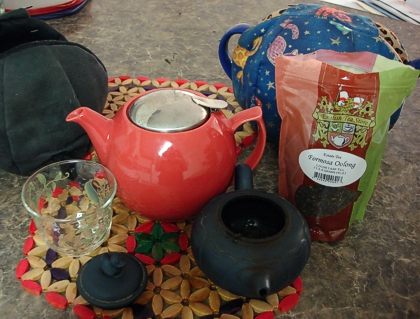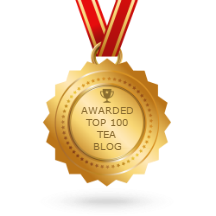I usually prefer to start my day with an oolong tea. Yes, I know that lots of tea drinkers need the “kick” of a strong black tea in the morning. But I like to ease into the day with a gentler cup.

Generally my tastes run to the lighter end of the oolong spectrum, to the greenish, less fermented, floral type of oolong referred to as pouchong or baozhong. Every so often, though, I find myself – through either choice or chance – with a pot of a darker, more roasted variety of oolong. Like this Formosa Oolong Estate Tea.
Now there are lots of types of oolongs from Taiwan, the island originally named Formosa by Portuguese explorers. (Formosa means “beautiful” in Portuguese.) And you can correctly call them all Formosa oolongs. The more or less generic term “Formosa oolong” on its own, however, is generally understood to describe a medium-fermented oolong comprising brownish broken leaves and stems, and a taste profile that is peachy or nutty or both.
When I prepare oolongs for general drinking, I use a procedure I refer to as “modified gong-fu style,” where I combine serial steepings into a larger teapot. A fellow tea lover who also enjoys this method laughingly calls it “oolong blasphemy.” On those occasions when I’m sampling a tea for the first time – that is, when I want to understand its flavor profile – I modify the process yet again by pouring a small amount from each steep into a cup for individual tasting before adding the rest to my sharing teapot.
As I did with this oolong. And discerned a somewhat unpleasant sharpness in the first steeping, kind of like nuts with the bitter skin still on them. I’m not talking about the initial brief “rinse,” which serves more to open the leaves to infusion rather than as any kind of washing, but to the first full steep after that. And it’s not just this oolong; I find that with darker oolongs in general I have to discard the first infusion. It’s just too harsh to my taste. The second infusion, however, was quite smoothed out, as were the following steeps.
Although the aroma when water first meets leaf is an extraordinary blend of charcoal and chocolate, the taste is more in the realm of roasted nuts. It has a dryness about it, neither sharp like walnuts nor sweet like pecans. Maybe filberts? It finishes with a subtle root-vegetable flavor. Sweet potatoes?
As I said, although I drink dark oolongs occasionally, they’re really not my favourites. Which is not to say that I won’t enjoy a pot every now and then, or that other tea drinkers won’t appreciate its qualities. What I do think its flavor profile is absolutely perfect for is my Hot and Sour Sesame Noodles recipe. In fact I think I’ll mix up a batch with it tonight!
© Online Stores, Inc., and The English Tea Store Blog, 2009-2014. Unauthorized use and/or duplication of this material without express and written permission from this article’s author and/or the blog’s owner is strictly prohibited. Excerpts and links may be used, provided that full and clear credit is given to Online Stores, Inc., and The English Tea Store Blog with appropriate and specific direction to the original content.



Leave a reply to Full-Leaf Tea v. Loose-Leaf Tea | Tea Blog Cancel reply